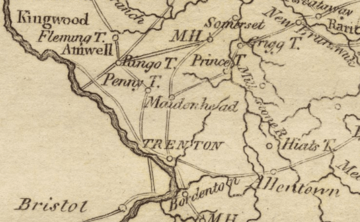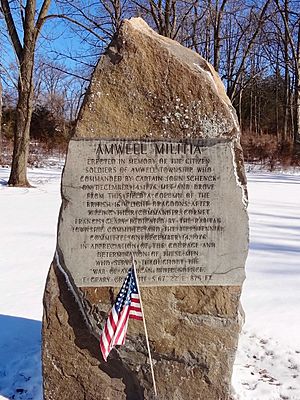Ambush of Geary facts for kids
Quick facts for kids Ambush of Geary |
|||||||
|---|---|---|---|---|---|---|---|
| Part of the American Revolutionary War | |||||||
 Cornet Francis Geary memorial site |
|||||||
|
|||||||
| Belligerents | |||||||
| Commanders and leaders | |||||||
| Cornet Francis Geary † | Captain John Schenck | ||||||
| Strength | |||||||
| 8 | 8 | ||||||
| Casualties and losses | |||||||
| One killed | None | ||||||
The Ambush of Geary, also called the Amwell Skirmish, was a small battle during the American Revolutionary War. It happened on December 14, 1776, in Amwell Township, New Jersey. A young British officer named Cornet Francis Geary was leading a group of dragoons (soldiers on horseback). He was shot in a surprise attack by local American militiamen, who were led by Captain John Schenck.
After British forces took over New York City, they set up military outposts across central New Jersey. Geary was based at a station in Pennington. When he was killed, his body was hidden and buried quickly. This stopped British troops from finding it. Years later, people became interested in the story. They found his grave and put up markers both in New Jersey and in England.
Killing Cornet Geary was one of many actions by American militia groups. These actions made British soldiers less likely to go on long scouting trips. This helped George Washington's crossing of the Delaware River succeed. It also contributed to the American victory at the Battle of Trenton.
Contents
Why the Ambush Happened
In the fall of 1776, General William Howe pushed George Washington's Continental Army out of New York City. Washington's army then retreated across New Jersey. General Charles Cornwallis chased them. Washington's troops crossed the Delaware River in early December. The British then started setting up places for their soldiers to stay for the winter. They created a line of outposts from Perth Amboy to Bordentown.
The British and their Hessian allies often sent out small groups of soldiers. These groups went on "reconnaissance" missions to gather information. They also went on "foraging" missions to find food and supplies. These small groups were easy targets for local American Patriot militia companies. The area around Trenton was especially dangerous for them. This outpost was commanded by Johann Rall and mostly had Hessian soldiers. A group of the 16th (Queen's) Light Dragoons was also stationed nearby at Pennington.
In early December, there were reports of bad actions by British and German soldiers in Hunterdon County, north of Trenton. These reports made more Patriot militia groups become active in the area.
Who Was Cornet Francis Geary?
Cornet Francis Geary was the oldest son of Admiral Sir Francis Geary. He was born in 1752 in England. He went to Balliol College, Oxford for his education. In 1773, he bought a position as a cornet in the 16th Light Dragoons. A cornet was a junior officer who carried the flag for a cavalry unit.
Geary was sent to North America in 1776. He arrived in New York in late September. In October and November, his unit mostly rode around northern New Jersey. They didn't face much organized fighting. But on December 1, his company was told to camp at Pennington. On December 14, Cornet Geary and seven other dragoons were sent north. Their mission was to scout the area.
The Surprise Attack
The best information about this battle comes from a statement given by John Schanck. He was the cousin of Captain John Schenck, who led the American militia. There aren't many detailed British reports about the event.
According to Schanck's account, Geary's group rode through Amwell Township towards Flemington. They were checking if a supply of salt beef and pork was ready for the army. John Schenck had heard about this movement the day before. When he learned about it, he gathered a few men, about eight in total. They set up a surprise attack in a wooded area. This spot was about 5 miles (8 km) south of Flemington.
When Geary's company rode by, the militia fired their muskets. Cornet Geary was killed. A British officer who heard about the event later said that Geary was warned about the attack. But he couldn't escape the gunfire. The dragoons fired back, but the continuing militia fire forced them to leave.
What Happened Next
The militiamen took some of Geary's uniform. This included his sword and a silver plate from his cap that had his name on it. British troops were sent to find Geary and the supplies. They asked local people and searched the area. But they couldn't find his body. The militiamen had hidden it. It was buried in a shallow grave the next day.
General John Burgoyne, who was the colonel of the 16th Light Dragoons, wrote to Admiral Geary. He expressed his sadness about Francis's death. He said that Francis had "met a Soldier's fate."
This ambush and other similar attacks by the militia made British troops more careful. They reduced how far they would scout. It became too dangerous to go more than about 4 miles (6.4 km) from Trenton. This was very important when the Americans started gathering boats along the Delaware River. This happened before George Washington's crossing of the Delaware River. That crossing led to the Battle of Trenton on December 26, 1776. Geary's troops were only about 5 miles (8 km) from the river and Malta Island. This island was where Washington's army prepared for the crossing.
Remembering the Ambush
Stories from Hunterdon County say that Geary's belongings were hidden. This was to prevent British troops from finding them. His coat was supposedly hidden under wheat in an attic. His boots were hidden in an oven. People also say his red sash was unraveled and used for decorations. His sword was melted down to make teaspoons. His stiff leather hat was used by a farmer to scoop oats for his horses.
Many local people in Hunterdon County didn't know Geary was buried there. Stories continued that the British had found his body. In 1891, the Hunterdon County Historical Society dug up a body from a suspected grave site. They found a skeleton and silver buttons marked "Q. L. D." This stood for the Queen's Light Dragoons. In 1907, his family placed a grave marker at the site. The St. Nicholas Church in Great Bookham, Surrey, England, has a bas-relief (a type of sculpture) showing Cornet Francis Geary and the ambush.
The ambush site is between Copper Hill and Larison's Corners in Raritan Township. On December 14, 1976, for the United States Bicentennial (200th anniversary), the township put up a monument to the Amwell Militia. The memorial monument for Geary, put up in 1907 by his great-nephew, Sir William Nevill Montgomerie Geary, is nearby. It's about 875 feet (267 m) away. A historical plaque describing the Amwell Skirmish is also next to his memorial.
Images for kids








